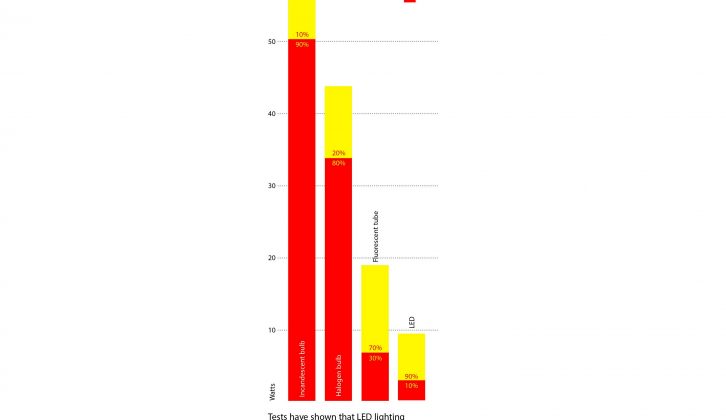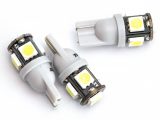LEDs (light-emitting diodes) are everywhere these days, in mobile phones, TVs, cars and motorhomes.
But what exactly are they?
Although widely accepted as an upgrade, are there any downsides to fitting LEDs in your motorhome?
What are LED lights?
LEDs are diodes, belonging to the semiconductor family. Semiconductors conduct current and insulate, both at the same time.
LEDs only work one way, so if wired back to front, they will not illuminate – reversing connections on LEDs allows them to light up.
They work by passing electrons through holes in junctions, to create photons, which we see as light.
Light bulbs and fluorescents
Light bulbs, which have not changed much since the 19th century, have a thin filament of tungsten wire.
When electrical current passes through the filament, it gets so hot that it glows.
The glass bulb contains an inert gas, to reduce the risk of the filament burning out and to protect the area from the intense heat.
Halogen bulbs work in exactly the same way. The big difference in halogen bulbs, however, is the type of gas and the glass, which has to be a fused silica or high melting-point glass.
Fluorescent tubes work by passing current into a glass tube and ionising vaporised mercury, which reacts with a phosphorus coating on the inside of the tube. They need extra components to maintain this reaction.
The benefits of LED lights
Compared with light bulbs, LEDs use a fraction of the power to generate the same amount of light.
This is ideal for motorhome owners staying off grid or wild camping, when not attached to an electric hook-up, or reliant on the leisure battery.
Scroll through our gallery above for the graph showing a comparison of power consumption for the various light sources.
Heat, toxicity, durability
The light from LEDs is generated by moving electrons, not heating a wire, so the heat generated is much less, too.
Some high-power LED lights do generate heat, but they are the exception.
In the finished LED product and during manufacturing, less harmful materials are used.
Th ey require tiny amounts of aluminium, gallium and nickel to create light of the correct colour, yet these materials rarely escape the outer shell.
LEDs are fantastically durable. They are not affected by damp, heat or cold.
They will continue to work if they suffer from vibration and, because they are not heating up and cooling down, they last a lot longer than light bulbs and fluorescent tubes.
A narrow spread of light
Before you rush out to buy LEDs, a few areas need consideration.
One of the biggest problems is that they only illuminate in one direction – upwards. A traditional light bulb illuminates in all directions.
To counter this, manufacturers stack multiple LED lights in amazing patterns to shine light in all directions. But this can cause some physical problems.
The extra LEDs take up more space and, in some cases, the number required to replicate a light bulb’s spread of light can mean the LED will not fit the housing.
So, do your research and check the available space.
Cost
LEDs have traditionally been more expensive when compared with light bulbs.
Th e truth is, the cost of running and replacing LED lights really makes the cost argument null and void.
LEDs’ lower power use and extended durability, plus the fact they outlive incandescent and fluorescent lights many times over, means that in the long run, upgrading to LEDs is extremely cost-effective.
Some LEDs can be expensive, for good reason. For example, their clustered format would make them more pricey, because of the additional components being added to the finished product.
Colours
LEDs are known for being colourful little devices, too. A variety of flashing, strobing and colour-changing LEDs can usually be found on campsites these days.
Colour LEDs are actually three LEDs in the same housing. A red, green and blue LED are mixed together, to create any colour you desire.
This works on the same principle as a TV pixel. These are commonly known as tricolour LEDs, and you can usually buy a long tape of these with a controller, so you can create your perfect colour.
Which colour white?
When choosing single-colour LEDs, you may even be given the opportunity to select which colour white you would prefer to have.
A choice between bright white and warm white is now quite common.
Warm white has more of a yellow hue to the final lighting, whereas a bright white actually seems quite blue.
An easy way to think of this is the colour difference between a light bulb and a fluorescent tube.
Both shine white, but they are not the same colours. We refer to this difference as a ‘colour temperature’.
Warm white has a temperature of 2700 Kelvin, whereas ‘daylight’ white has a temperature of 7000K.
The lower the number, the more yellow or orange the light will appear – the higher the number, the whiter it will be, eventually reaching the blue end of the spectrum.
Extra components for motorhomes
Bare LEDs work on 3V. To allow them to run on 12V in the motorhome, extra components are added.
This usually involves a resistor, which resists the voltage and only allows small amounts of power through.
This is a bit like standing on a hosepipe to reduce the flow of water.
The extra voltage is then converted to heat. The amount of heat created is minimal, although high-power LEDs will generate a lot more heat.
In this case, it is not uncommon to find heat sinks bolted to the LED housing, which will help to dissipate the heat away from the LED and prolong its life.
Types of LED lights
Now for a few practical pointers on what to look for when you are shopping for your LED lights.
They come in a wide variety of shapes and sizes – it really does depend on the application you have in mind.
If you want to replace a bulb with an LED equivalent, start by searching for the bulb type and adding the LED after it. For example, search for ‘501 LED’ or ‘GU10 LED’.
If you’re buying strips of LEDs, you will notice that they have a variety of numbers, such as 3528 or 5050 – what do these mean?
The numbers indicate the size of the LED package in millimetres, so 3528 strips measure 3.5mm x 2.8mm.
This means that you get smaller components, and possibly more of them, in a given length of LEDs.
The 5050 LED strips measure 5.0mm x 5.0mm. These LEDs are bigger and less numerous.
The benefit is lower power consumption for the same level of light, but the light is not as unified as that from 3528 LEDs.
The subject of LEDs is huge – I could easily carry on and on discussing projects and pitfalls.
But hopefully by now, you have enough knowledge to understand how they work and the things to be aware of, and you have some practical guidance, too.
LEDs use a fraction of the power to generate the same amount of light

















